69 142 Definition A sexually transmitted infection caused by the Treponema pallidum bacterium, a spirochete. It is passed from person to person through direct contact with the infectious exudates from obvious or concealed moist, early lesions of skin and mucous membranes of infected people during sexual intercourse. Sores mainly occur on the external genitals in the vagina, anus, or rectum and also can occur on the lips and in the mouth. Syphilis can be passed from an infected woman to her fetus because the bacterium crosses the placenta. Of increasing con- cern is the fact that syphilis increases the risk of transmitting and acquiring HIV. Syphilis is a disease reportable to local public health authorities. Characteristics Syphilis has 4 stages: primary, secondary, latent, and tertiary (late). It is highly contagious during the primary and secondary stages. The primary stage is marked by the appearance of an ulcer (chancre) at the location where the bacterium has entered the body. The chancre is usually firm, round, small, and painless, with serous exudate. It occurs 10 days to 6 weeks after exposure and generally heals on its own, regardless of treatment. If not treated, the in- dividual progresses to the secondary stage. The secondary stage occurs 1 week to 6 months after the primary stage. It begins when one or more areas of the skin erupt(s) in a symmetrical maculopapular rash characterized as brown sores about the size of a penny (“copper penny” spots) that usually do not itch. Al- though the rash may cover the whole body or appear only in a few areas, the palms of the hands and soles of the feet almost always are involved. Other symptoms may occur, such as mild fever, fatigue, headache, sore throat, as well as patchy hair loss and swollen lymph glands. These symptoms may be very mild and will disappear without treatment within a few weeks or up to 12 months. An infected person who has not been treated may infect others during the primary and secondary stages, which usually last 1 to 2 years. If untreated, syphilis may lapse into a latent stage during which the disease is no longer con- tagious and no symptoms are present. However, a person can develop the complications of tertiary or late syphilis in which the bacteria damage the heart, eyes, brain, nervous system, bones, joints, or almost any other part of the body. Finally, late syphilis can result in mental illness, blindness, other neurological problems, heart disease, and death. A blood test may be the only indication of disease process and secondary symptoms may recur in this stage. Syphilis usually is treated with penicillin as an injection. Other antibiotics can be used for those allergic to penicillin. Although treatment is available, the early symptoms of syphilis can be extremely mild, and many people do not seek treatment when they first become in- fected. Policy Ensure that the symptomatic employee is referred to personal health care provider or local health department for evaluation and treatment, as well as supported, counseled, and edu- cated about the disease and its transmission. Maintain employee confidentiality. Syphilis Guideline continues on next page
Purchased from OEM Press by (ge corporate access). (C) 2013 OEM Health Information, Inc. All rights reserved.












































































































































































































































































































































































































































